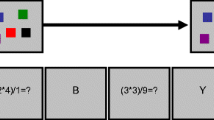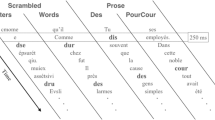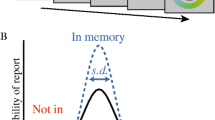Summary
Typically, people can only report about four or five items from a briefly presented array of alphanumeric items. A new span task was used to explore the basis of this limitation. In Experiment l, performance suffered when very brief display durations were combined with a verbal-load task, but no significant effects of display duration were found when there was no verbal load. In Experiment 2, a similar interaction was observed between verbal load and the presence of a visual suffix; performance was worse in the verbal-load condition with a visual suffix, but no such effect was observed without verbal load. In both experiments, poorer performance was associated with enhanced serial-position effects. The results can be explained on the assumption that the verbal-load task required some processing resources, and that the quality of information in visual working memory depends on available resources. Thus, both brief-array presentation and the visual suffix degrade the information in visual working memory, but span performance is impaired only when processing resources are relatively scarce.
Similar content being viewed by others
References
Baddeley, A. (1986). Working memory. Oxford: Clarendon.
Briand, K. A., & Klein, R. M. (1988). Conceptual masking in brief visual displays. Canadian Journal ofPsychology, 42, 496–502.
Cattell, J. M. (1885). On the time required for recognizing and naming letters and words, pictures and colors. Philosophische Studien, 2, 635–650.
Coltheart, M. (1980). Iconic memory and visible persistence. Perception & Psychophysics, 27, 183–228.
Conrad, R. (1964). Acoustic confusions in immediate memory. British Journal of Psychology, 55, 75–84.
Crannell, C. W., & Parrish, J. M. (1957). A comparison of immediate memory span for digits, letters and words. Journal of Psychology, 44, 319–327.
Dick, A. O. (1971). On the problem of selection in short-term visual (iconic) memory. Canadian Journal of Psychology, 25, 250–263.
Di Lollo, V. (1978). On the spatio-temporal interactions of brief visual displays. In R. H. Day & G. V. Stanley (Eds.), Studies in perception (pp. 39–55). Perth: University of Western Australia Press.
Di Lollo, V., & Dixon, P. (1988). Two forms of persistence in visual information processing. Journal of Experimental Psychology: Human Perception and Performance, 14, 671- 681.
Di Lollo, V., & Moscovitch, M. (1983). Perceptual interference between spatially separate sequential displays. Canadian Journal of Psychology, 37, 414–428.
Dixon, P. (1985). The category effect in visual detection and partial report. Perception & Psychophysics, 38, 286–295.
Dixon, P. (1986). Attention and interference in the perception of brief visual displays. Journal of Experimental Psychology: Human Perception and Performance, 12, 133–148.
Dixon, P., & Di Lollo, V. (1991). Effects of display luminance, stimulus type, and probe duration on visible and schematic persistence. Canadian Journal of Psychology, 45, 54–74.
Dixon, P., & Twilley, L. T. (1988). Location confusions in visual information processing. Canadian Journal of Psychology, 42, 378–394.
Drewnowski, A. (1980). Attributes and priorities in short-term recall: A new model of memory span. Journal of Experimental Psychology: General, 109, 208–250.
Duncan, J. (1980). The locus of interference in the perception of simultaneous stimuli. Psychological Review, 87, 272–300.
Estes, W. K. (1982). Similarity-related channel interaction in visual processing. Journal of Experimental Psychology: Human Perception and Performance, 8, 353–382.
Estes, W. K., & Taylor, H. A. (1964). A detection method and probabilistic model for assessing information processing from brief visual displays. Proceedings of the National Academy of Sciences, 52, 446–454.
Frick, R. W. (1989). Recency and the modality effect in immediate ordered recall. Canadian Journal of Psychology, 43, 494–511.
Gardner, G. T. (1973). Evidence for independent parallel channels in tachistoscopic perception. Cognitive Psychology, 4, 130–155.
Grier, J. B. (1971). Nonparametric indexes for sensitivity and bias: computing formulas. Psychological Bulletin, 75, 424–429.
Irwin, D. E., & Yeomans, J. M. (1986). Sensory registration and informational persistence. Journal of Experimental Psychology: Human Perception and Performance, 12, 343–360.
Kahneman, D. (1973). Attention and effort. Englewood Cliffs, NJ: Prentice-Hall.
Loftus, G. R., Johnson, C. A., & Shimamura, A. P. (1985). How much is an icon worth? Journal of Experimental Psychology: Human Perception and Performance, 11, 1–13.
Merikle, P. M., & Coltheart, M. (1972). Selective forward masking Canadian Journal of Psychology 26, 296–302.
Merikle, P. M., Coltheart, M., Lowe, D. G. (1971). On the selective effects of a patterned masking stimulus. Canadian Journal of Psychology, 25, 264–279.
Mewhort, D. J. K. (1974). Accuracy and order of report in tachistoscopic identification. Canadian Journal of Psychology, 28, 17–26.
Mewhort, D. J. K., & Campbell, A. J. (1978). Processing spatial information and the selective-masking effect. Perception & Psychophysics, 24, 93–101.
Phillips, W. A., & Christie, D. F. M. (1977). Components of visual memory. Quarterly Journal of Experimental Psychology, 29, 117–133.
Pollack, I., & Norman, D. A. (1964). A nonparametric analysis of recognition experiments. ,Psychonomic Science 1, 125–126.
Scarborough, D. L. (1972). Memory for brief visual displays of symbols. Cognitive Psychology, 3, 408–429.
Sperling, G. (1960). The information available in brief visual presentations. Psychological Monographs, 74 (Whole No. 498).
Sperling, G. (1963). A model for visual memory tasks. Human Factors, 5, 19–31.
Sperling, G. (1967). Successive approximations to a model for shortterm memory. Acta Psychologica, 27, 285–292.
Sperling, G., & Speelman, R. G. (1970). Acoustic similarity and auditory short-term memory: Experiments and a model. In D. A. Norman (Ed.), Models of human memory. New York: Academic.
Townsend, V. M. (1973). Loss of spatial and identity information following a tachistoscopic exposure. Journal of Experimental Psychology, 98, 113–118
Turvey, M. T. (1978). Visual processing and short-term memory. In Human information processing (Vol. 5, pp. 91–142).Hillsdale, NJ: Erlbaum.
van der Heijden, A. H. C. (1981). Short-term visual information forgetting. London: Routledge & Kegan Paul.
Wickelgren, W. A. (1965). Acoustic similarity and intrusion errors in short-term memory. Jorunal of Experimental Psychology 70 102–108.
Wolford, G. (1975). Perturbation model for letter identification. Psychological Review, 82, 184–199.
Wolford, G., & Hollingsworth, S, (1974 a). Evidence that short-term memory is not the limiting factor in the tachistoscopic full-report procedure. Memory & Cognition, 2, 796–800.
Wolford, G., & Hollingsworth, S. (1974b). Retinal location and string position as important variables in visual information processing. Perception & Psychophysics, 16, 437–442.
Author information
Authors and Affiliations
Rights and permissions
About this article
Cite this article
Dixon, P., Shedden, J.M. On the nature of the span of apprehension. Psychol. Res 55, 29–39 (1993). https://doi.org/10.1007/BF00419891
Received:
Accepted:
Issue Date:
DOI: https://doi.org/10.1007/BF00419891




